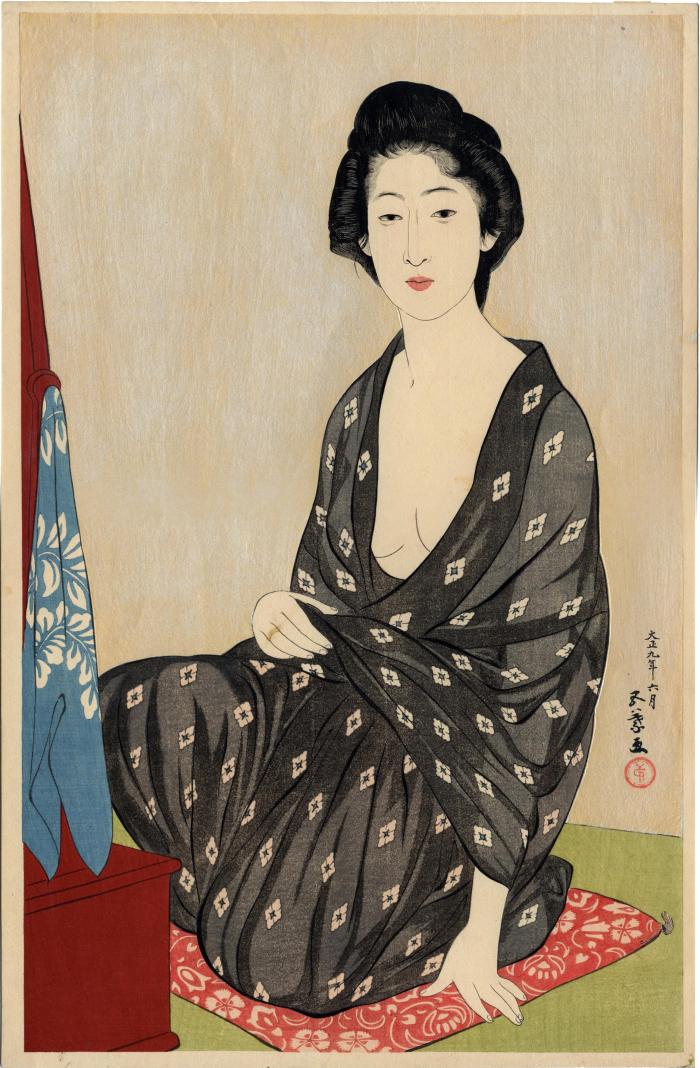Hashiguchi Goyō (橋口五葉) (artist 1880 – 1921)
Woman in a summer kimono (Natsui no onna - 夏衣の女)
06/1920
11.5 in x 17.75 in (Overall dimensions) Japanese woodblock print
Signed: Goyō ga (五葉画)
Artist's seal: GY in circle
Dated: Taishō kunen rokugatsu
(Sixth Month, Ninth Year of Taishō - 大正九年六月)
Museum of Fine Arts, Boston
Metropolitan Museum of Art
British Museum
Honolulu Museum of Art
Harvard Art Museums
Hagi Uragami Museum of Art
Chazen Museum of Art
Los Angeles County Museum of Art
Walters Museum of Art
Spencer Museum of Art
Yale University Art Gallery
Minneapolis Institute of Arts
Nelson-Atkins Museum of Art
Achenbach Foundation for Graphic Arts
Yamamoto Art Museum
The Art Institute of Chicago
Ishikawa Prefectural Museum of Art
Museum für Ostasiatische Kunst, Köln
Östasiatiska Museet, Stockholm
The Chester Beatty Library Kendall Brown wrote in Shin-Hanga: New Prints in Modern Japan: "For models Goyō often used waitresses and maids rather than geisha. This choice, no doubt based on economic factors, nonetheless resulted in Goyō's immortalizing these women, who in many ways were the Taishō equivalent of Utamaro's geisha. Goyō's favorite model was Nakatani Tsuru, a waitress at Osaka's Ichō restaurant, whom he brought to live in his Akasaka home-studio. In Woman in Summer Kimono... Nakatani stares at the viewer as she sits before a mirror pulling a transparent summer kimono over her body. The solid, three-dimensional treatment of her body visible beneath the pattern of the robe shows Goyō's method of almost literally dressing his naturalistic drawing in decorative design."
****
A different title is given by Helen Merritt in Modern Japanese Woodblock Prints: The Early Years, University of Hawaii Press, Honolulu, 1990 where the print is illustrated in color.
Tsuru sits before a traditional dressing-table and mirror-stand on a 'zabuton' (flat cushion), wearing a transparent 'yukata' (summer bathrobe). On page 72 it says: "Most of Goyo's models were waitresses, bu the prints for which they posed have a quiet dignity which suggests that the models were well-bred women of culture and refinement. The quality, which was probably the embodiment of Goyō's ideal of feminine beauty, is most marked in Nakatani Tsuru Seated Before the Dressing Stand, 1920... Nakatani Tsuru, in the simplest of sheer garments\, sits in repose. She fills the space with quiet, classic elegance - elegance that is enhanced by the sensitive printing of the garment and the suggest solidity of the limbs beneath it."
The carver was Koike Masazō and the printer was Akimoto Shōzaburō.
There are other copies in the Ishibi Prefectural Museum, the Keio University Library, the San Diego Museum of Art, the Edo-Tokyo Museum and the Toledo Museum of Art.
****
Illustrated:
1) In color in Fresh Impressions: Early Modern Japanese Prints, #7, p. 81.
2) In a small black and white illustration in Shin-Hanga: New Prints in Modern Japan, p. 61, Figure 73.
3) In a black and white exhibition in 近代日本美人画展 : 伝統木版画を支えた作家たち Exhibition of Modern Japanese Beauties: Meiji, Taishō, Shōwa, Riccar Art Museum, 1982, n.p., no. 46.
4) In a small black and white reproduction in 原色浮世絵大百科事典 (Genshoku Ukiyoe Daihyakka Jiten), vol. 1, p. 141.
5) In a small black and white reproduction in The Japanese Print Since 1900: Old Dreams and New Visions by Lawrence Smith, p. 55.
6) In The Female Image: 20th century prints of Japanese beauties, Abe Publisher, 2000, #15, p. 41.
7) In color in Seven Masters: 20th-Century Japanese Woodblock Prints from The Wells Collection, Minneapolis Institute of Arts, 2015, p. 56.
8) In a small black and white reproduction in The Evolution of Ukiyo-e: The Artistic, Economic and Social Significance of Japanese Wood-block Prints< by Sei-ichirō Takahashi, 1955, page 137.
modern prints (shin hanga - 新版画) (genre)
beautiful women (bijin-ga - 美人画) (genre)
Taishō era (大正時代) (genre)
